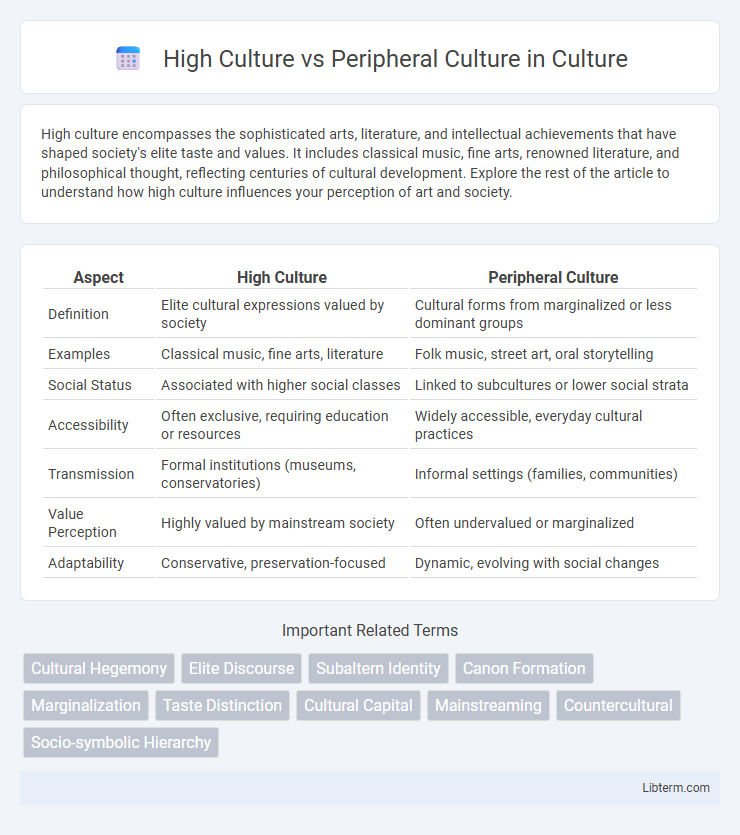High culture encompasses the sophisticated arts, literature, and intellectual achievements that have shaped society's elite taste and values. It includes classical music, fine arts, renowned literature, and philosophical thought, reflecting centuries of cultural development. Explore the rest of the article to understand how high culture influences your perception of art and society.
Table of Comparison
| Aspect | High Culture | Peripheral Culture |
|---|---|---|
| Definition | Elite cultural expressions valued by society | Cultural forms from marginalized or less dominant groups |
| Examples | Classical music, fine arts, literature | Folk music, street art, oral storytelling |
| Social Status | Associated with higher social classes | Linked to subcultures or lower social strata |
| Accessibility | Often exclusive, requiring education or resources | Widely accessible, everyday cultural practices |
| Transmission | Formal institutions (museums, conservatories) | Informal settings (families, communities) |
| Value Perception | Highly valued by mainstream society | Often undervalued or marginalized |
| Adaptability | Conservative, preservation-focused | Dynamic, evolving with social changes |
Defining High Culture and Peripheral Culture
High culture encompasses the set of cultural products, practices, and values traditionally associated with the elite or dominant social groups, including classical music, fine arts, literature, and philosophy. Peripheral culture refers to the cultural expressions and traditions of marginalized or less dominant communities, often characterized by folk art, popular music, and localized customs. The distinction highlights power dynamics in cultural valuation, where high culture is seen as canonical and peripheral culture as diverse but undervalued.
Historical Evolution of Cultural Hierarchies
High culture historically emerged from elite classes, emphasizing classical arts, literature, and formal education as markers of social status. Peripheral culture, often rooted in local traditions and folk practices, evolved as a counterpoint, preserving marginalized voices and regional identities. Over time, cultural hierarchies fluctuated with socio-political shifts, democratization, and globalization, challenging the rigid distinctions between elite and popular cultural forms.
Key Characteristics of High Culture
High culture is characterized by its association with elite art forms, classical music, literature, and intellectual pursuits that are often preserved and promoted by cultural institutions such as museums, universities, and theaters. It emphasizes depth, complexity, and historical significance, appealing to a more educated and affluent audience that values tradition and refinement. High culture often serves as a marker of social status and identity, distinguishing itself from popular or peripheral cultures through exclusivity and a focus on canonical works.
Distinctive Traits of Peripheral Culture
Peripheral culture is characterized by its marginalization from dominant societal norms, often preserving unique linguistic, artistic, and ritualistic expressions that resist homogenization. These cultures prioritize communal values and oral traditions, maintaining a deep connection with local history and environment. Distinctive traits include adaptive resilience, symbolic storytelling, and the preservation of indigenous knowledge systems that contrast with the standardized forms of high culture.
Power Dynamics and Cultural Legitimacy
High culture commands power dynamics by establishing cultural legitimacy through institutions like museums, universities, and elite media, reinforcing social hierarchies. Peripheral culture challenges this dominance by representing marginalized voices and alternative narratives that contest elite definitions of taste and value. The struggle over cultural legitimacy reveals underlying power structures that determine which cultural expressions are valorized or marginalized.
Media Representation of Cultural Forms
High culture is often portrayed in media as elite, sophisticated, and traditionally valued artistic expressions such as classical music, fine arts, and literature. Peripheral culture, encompassing marginalized or subcultural groups, is frequently depicted through alternative media channels, emphasizing grassroots creativity, resistance, and hybrid identities. Media representation shapes public perception by privileging canonical cultural forms while rendering peripheral cultures either exoticized or underrepresented.
Social Impact and Audience Access
High culture often centers on elite art forms such as classical music, fine arts, and literature, typically accessible to a privileged audience with higher education and socioeconomic status. Peripheral culture includes popular, folk, and subcultural expressions that resonate with broader, more diverse communities, fostering inclusivity and grassroots social cohesion. The social impact of high culture tends to reinforce existing social hierarchies, while peripheral culture promotes cultural democratization and greater audience accessibility across different social groups.
Globalization and Cultural Exchange
High culture, typically characterized by elite art, literature, and classical music, often originates from Western societies and serves as a global benchmark through institutions like museums and universities. Peripheral cultures contribute dynamic, localized expressions such as folk traditions, indigenous music, and regional crafts, which gain international visibility via globalization and digital platforms. Cultural exchange fosters hybrid identities and cross-cultural innovation, reshaping both high and peripheral cultures in an interconnected global landscape.
Challenges to Cultural Boundaries
High culture often faces challenges to its cultural boundaries from peripheral cultures that introduce alternative narratives, artistic expressions, and values. These peripheral cultures question the dominant cultural norms by highlighting marginalized perspectives and promoting inclusivity, which can disrupt traditional hierarchies within the arts, literature, and social practices. The tension between maintaining exclusivity in high culture and embracing diversity from peripheral cultures drives ongoing debates about cultural legitimacy and access.
Future Trends in Cultural Diversity
Future trends in cultural diversity emphasize the blending and coexistence of high culture and peripheral culture, driven by global connectivity and digital platforms that amplify marginalized voices. Emerging technologies facilitate cross-cultural exchanges, allowing peripheral cultures to gain recognition and influence within traditionally dominant cultural narratives. This dynamic interplay fosters a more inclusive cultural landscape, challenging hierarchical distinctions and promoting innovation in artistic and social expressions.
High Culture Infographic

 libterm.com
libterm.com